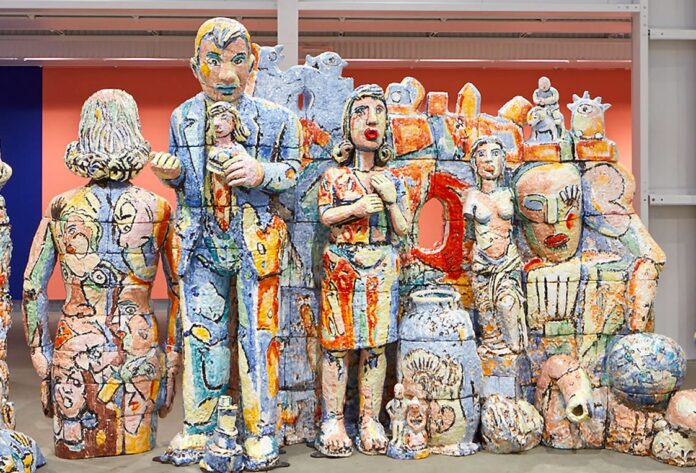It would require an industrial-size warehouse to physically house the prolific output of Lodi-born, Oakland-based artist Viola Frey (1933-2004), known especially for her towering ceramic works. Fortunately, Frey’s multidisciplinary artwork created during a more than 50-year career has indeed been gathered in such a place, and today resides in Oakland’s Viola Frey Archives.
The collection is stewarded and managed by the Artists’ Legacy Foundation. Under its purview and a team led by Director of Collections and Archive Cynthia de Bos, Frey’s paintings, drawings, sculptures, photographs, papers, and other materials have been organized and prepared for exhibitions, public programs, and publications.
The most immediate opportunity to experience Frey’s artwork firsthand is a solo exhibition of her work called “Transitory Fragments” at pt. 2 Gallery in Oakland, on display through Sat/22. People unable to visit the exhibit before it closes will be comforted to know they have access to Frey’s work via a comprehensive, freshly published 228-page monograph, Viola Frey: Artist’s Mind/Studio/World.
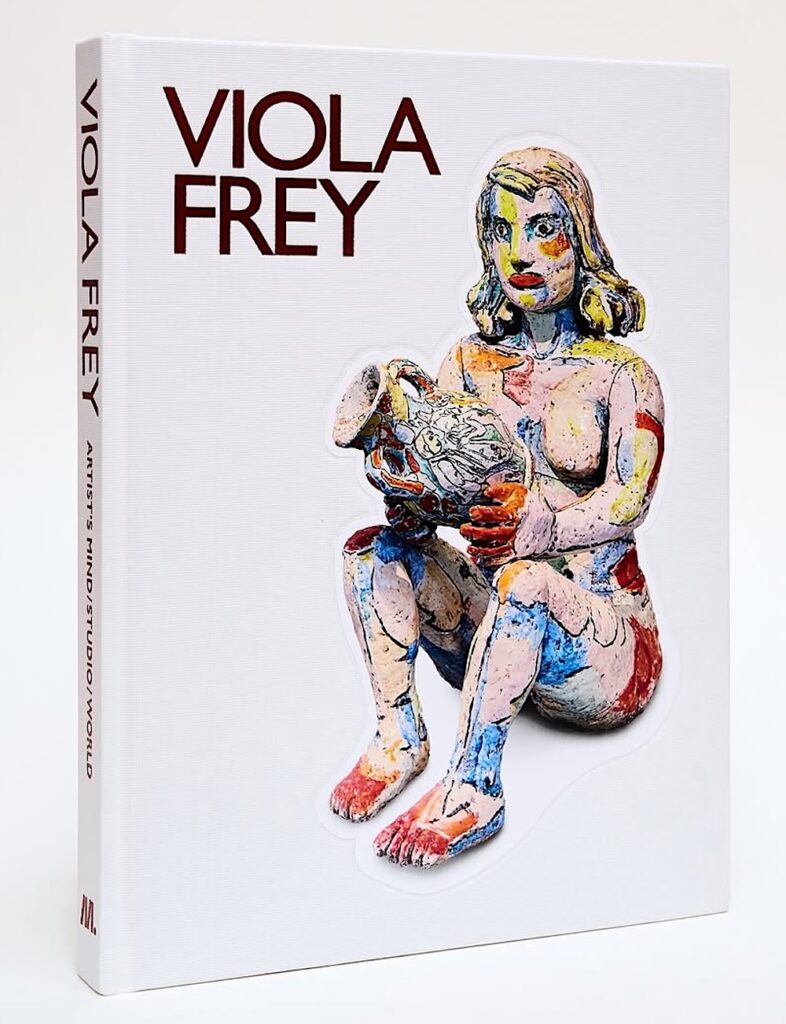
Overseen by de Bos, the generously illustrated book includes not only well-chosen images of Frey’s vast artwork and photographs of her engaged in her artistic practices, there are never-before-seen newspapers clippings, correspondence, slides, and photographs. Essays from de Bos, Nancy Lim, Jenelle Porter, and Jodi Throckmorton and an excellently presented chronology encompass career milestones and provide historical context about her life and the world in which Frey exercised her vision.
Investigation into the reasons and examples of Frey’s work shows her needle-shifting influence remains undimmed, vivacious, progressive. Her influence has only grown in recent years on the current generation of young artists: Once a vanguard, always a vanguard—a statement proven true by viewing her artwork and learning of the craft behind it all.
Although Frey is best known for those large-scale figurative sculptures, past and current exhibits and especially the book open up her artistic practice and complete body of work. Through lines emerge between mediums and across decades, and the artist’s childhood experiences growing up on a Central Valley grape farm amidst decaying farm equipment and vehicles combine to clarify her art’s evolution.
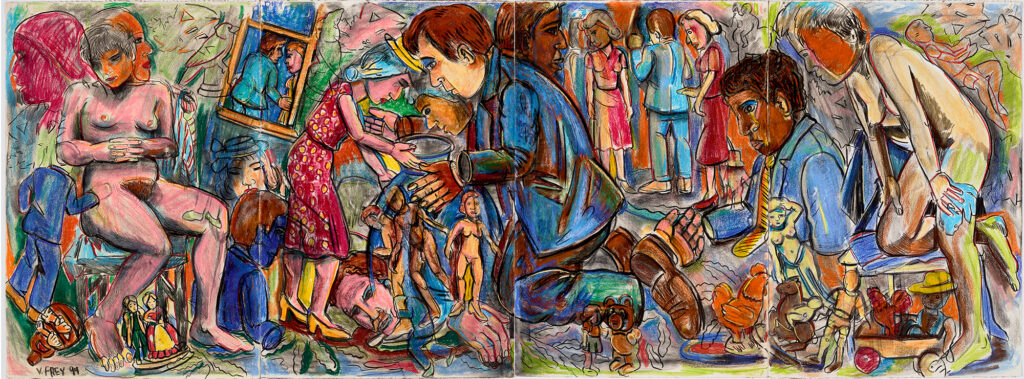
The inclusion in the book of an essay Frey wrote, “Briefly,” has the artist speaking in her own voice in answer to a self-directed question: “What have I done with clay?” The essay’s last two sentences, “I have attempted to make a permanent whole of the transitory fragments I have seen around me. Clay has the quality of right now!” express most explicitly the energy propelling her relentless pursuit of whatever idea, method, medium, and approach was most vivid, most “right now.”
“I first encountered her work when I was a student, interning at di Rosa (Center for Contemporary Art) in 2008,” says de Bos. “I remember walking up to one of her monumental seated women sculptures. I’d never seen such scale and color and the medium of ceramics in a larger-than-life sculpture. I was used to sculpture being bronze, steel, marble. It just held the floor and was so exciting.”
The decision to later create a book encompassing her life and work was sparked by an exhibit at di Rosa a decade later. Brought on in 2013 to organize the archives, de Bos noticed the contrast between press coverage Frey had received and the lack of published material about her legacy. “There was a large void. With that in mind, I set out in 2019 to pinpoint the connections in her bodies of work. Who better than the Viola Frey Archive to answer my questions?”

Areas of thought, not a linear narrative, in part tells Frey’s story. Instead of “a farm girl collected endless items— figurines, plastic dolls, tabletop and kitchen goods, bookends, planters, aquarium decorations, hats, shoes, dresses, flea market finds, miscellaneous broken and found objects, and more—and used them to create figurative art,” the monograph delves into how Frey expressed different ideas through different mediums.
“The origins of her work is in one essay,” says de Bos. “Another is how her artwork is affected by her environment. Another is the concept of the gendered dynamics of power she used as source material. Once you understand where and in what time period things were being made, you understand the changing medium and scale.”
The importance of place and time in Frey’s development as an artist are obvious when a reader learns of the live/work space she acquired upon purchasing a property at 663 Oakland Avenue. The spacious primary painting and drawing studio created by combining the home’s living and dining rooms, an adjacent ceramic studio, and the entire backyard became her domain for moving into large-scale sculptures and installations and allowed her to store enormous supplies of materials.
“She went so far as to keep and repurpose things that broke. Instead of remaking something fired in the kiln, she’d put the fragments back together, make something new, and just keep going. Even so, her use of color and dimension and texture were precise. That’s why including her essay, her words about clay, was so important to me. We can forget intention when we’re interpreting an artist’s work.”
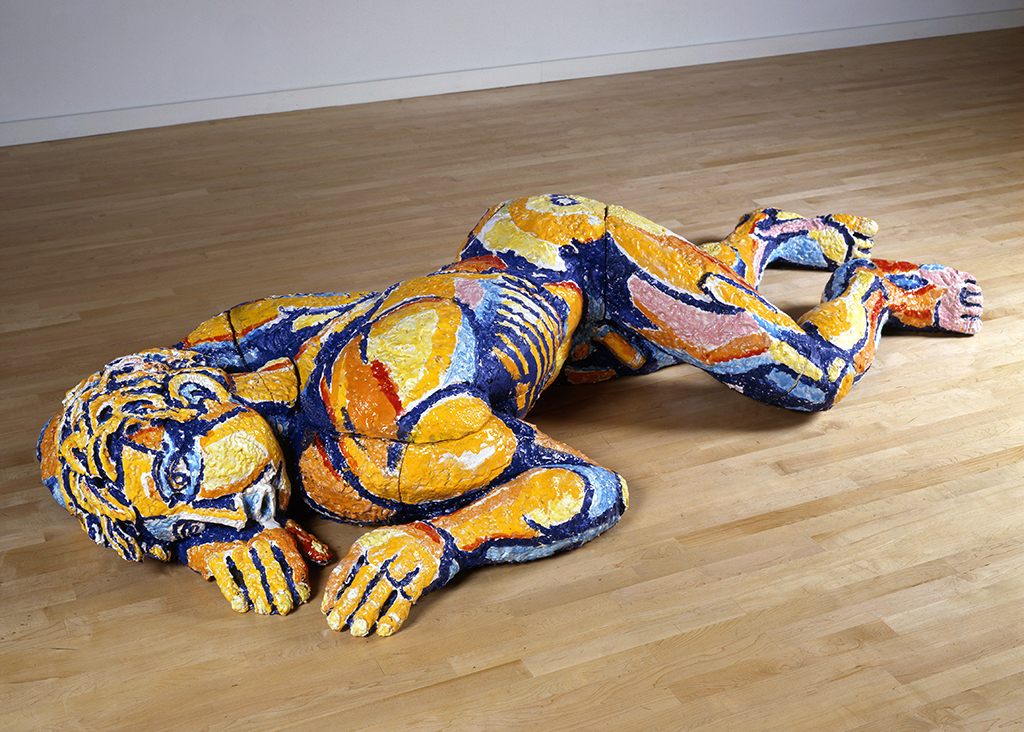
Asked to speak about specific works in the exhibit or the book, de Bos says “Frey with Prone Man,” a photo of Frey and the sculpture from 1987, has Frey deliberately showing a male nude in a vulnerable position. “It came out of the AIDS epidemic, when she was losing friends and associates. When you look at classical male sculpture, there is not a prone man. Instead they are on a horse, or in a strong stance. I like that you can see her fingerprints. It’s not a pristine surface, which shows the painterly quality of clay. It’s so different from production pottery. This piece is about imperfections and the artist’s hand.”
“Untitled (Wall Hanging of Female Figure),” 1965, is composed with ceramic and glaze. “I love it because it’s actually slab. She rolled out the clay and then pushed it together. She didn’t hand-build it or use the wheel. She took two plates and pushed the dough together to create this mountain range shape.”
Another work titled “Untitled,” is oil on canvas and employs clusters of cut-out, stenciled figures. “This one is a double-layered canvas. On the top layer, she cuts away the silhouettes and let’s the edges peel. On the second layer she paints a 3-D dimension. You get a sense of depth, a sense of shadow, and a certain color vibration. She borrowed color theory, then applied glaze theory, and played with light sensitives in the studio. Between artificial light on the canvas, the contrasting colors, and shadow elements create movement on the canvas.”
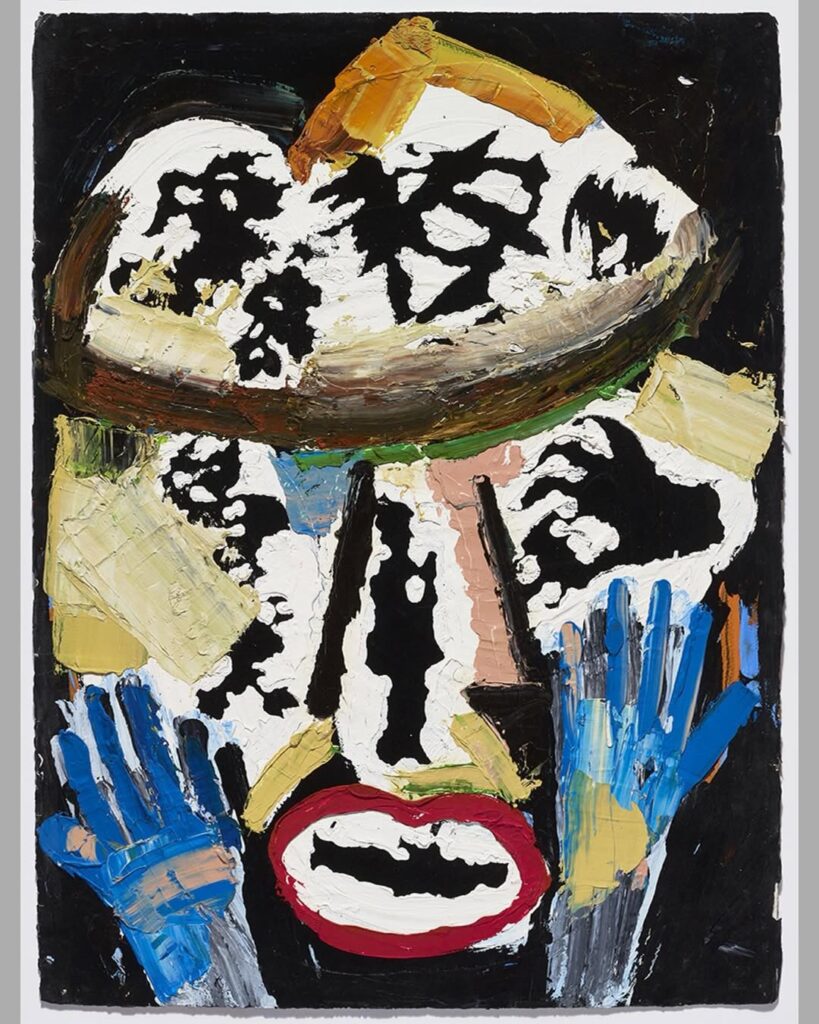
Other paintings use a layer of thick, black oil paint with white paint applied over it and carved or scratched with a technique know as sgraffitol. The 1980s “Greedy Grandmother” series of paintings includes “Untitled, (Blue Hands, Hat of Figurines).” As if working with a glaze on a ceramic piece, a fine scraping tool and stencil cutouts of figurines become black voids. “You loose the fidelity of the edges because the paint is so thick. She was fascinated with grandmothers, because there was always one we loved, and one we didn’t care for.”
“The Decline and Fall of Western Civilization,” a ceramic sculpture made in 1992, is indicative of Frey’s overall oeuvre. “It’s everything she ever did in one piece. It’s 20 feet wide and 8-9 feet tall,” says de Bos. “She took cast offs she didn’t like that were in her studio. Rather than throwing them away, she kept them, repurposed them, and created this magnificent wall you can walk around. The glazes interact with each other, all molten and weepy. There’s texture and varied scale that’s reminiscent of her drawings and paintings.”
A piece de Bos deliberately placed at the end of the book is “Seated White Majestic Woman.” Uncharacteristically, it is absent her usual, vibrant, loopy color palette. “She made it in 2004 for her final exhibit. She knew she was dying. She purposely didn’t paint it. It was her closing moment: not a fade to black; a fade to white. It’s also a nod to classical sculpture, where the paint has worn away and only the raw material is left. Time has passed and all we have left is this white sculpture. There’s a companion piece of a white man standing, but I love this one most. Although she’s having to hold herself up (with her arms), she’s definitely seated. She’s at rest.”

